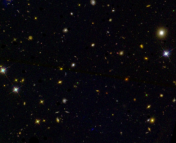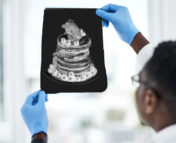Paper Title: Can luminous Lyman alpha emitters at z ~ 5.7 and z ~ 6.6 suppress star formation?
Authors: Daryl Joe D. Santos, Tomotsugu Goto, Tetsuya Hashimoto, Seong Jin Kim, Ting-Yi Lu, Yi-Hang Valerie Wong, Simon C.-C. Ho, Tiger Y.-Y. Hsiao
First Author’s Institution: Institute of Astronomy, National Tsing Hua University, Taiwan & Max Planck Institute for Extraterrestrial Physics, Germany
Status: Accepted in MNRAS [closed access]
How does the lone, rural galaxy evolve compared to one in a crowded city full of lights? The role of environment on galaxy formation and evolution is a complex problem that remains unclear. How densely surrounded galaxies are – by other galaxies and by radiation – has implications for how big structures and clusters of galaxies form, as well as how star formation gets triggered and later turned off or quenched.
Star-forming galaxies, which are commonly detected through an emission line from the Lyman-alpha (n=2 to n=1) transition of hydrogen, are a source of high energy radiation and are potentially a site of galaxy clustering. The impact of environment on the evolution of these Lyman-alpha emitters (LAEs) is still hazy enough that many studies have somewhat conflicting conclusions as to what’s going on. Do they tend to cluster? Does their presence enhance or suppress the formation of stars? In today’s paper, the authors venture to answer these questions by taking a statistical sample of LAEs at early times, about a billion years after the Big Bang.
More specifically, their investigation centers around the impact of ionizing radiation in the ultraviolet wavelength range on the evolution of and star formation within galaxies in the early Universe. While the physical processes to suppress or quench ongoing star formation is also not fully understood, the presence of strong ultraviolet radiation is one potential method of quenching, as it prevents gas from collapsing into stars.
If you emit it then you shoulda put a ring on it
A defining characteristic of LAEs is their ionizing emission in the ultraviolet wavelength range. This radiation can come from ongoing star formation and/or an active central supermassive black hole. From their prominent Lyman-alpha emission lines, LAEs can be selected either via precise spectroscopic observations or through narrow band imaging, which uses a filter to take an image while only collecting light around a specific wavelength range (in other words, a narrow band of the electromagnetic spectrum). If a galaxy has excess brightness in the narrow band image and we have some guess already that the source of the detection is a Lyman-alpha emission line, we can calculate an approximate redshift.
This paper relies on this technique for a large area narrow band survey with Hyper Suprime-Cam on the Subaru Telescope, which resulted in a large sample of candidate LAEs at z ~ 5.7 and z ~ 6.6. These specific redshifts are derived from to the redshifted the Lyman-alpha line corresponding to the wavelength of the narrow band filters used. Once the sample was built, with ~1000 LAEs in each redshift bin, the authors analyzed the number of faint LAEs around bright LAEs (therefore, those with more ionizing radiation) within rings of increasing radius around the central LAE. They then placed these rings at certain distances from the central bright LAE to probe their environments on different scales, from the individual galaxy level to large voids in the cosmic web.
Why we should care about the environment
For the z ~ 5.7 sample, the authors found that the density of faint LAEs around the central bright LAEs decreased as the intrinsic brightness of the central galaxy increased (see Figure 1). Their interpretation: central LAEs’ ionizing photons suppress star formation of galaxies around them. With their star formation quenched, the galaxies around them tend to not emit Lyman-alpha, so fewer galaxies in the environment are observed as LAEs. While stronger radiation within smaller rings explains a higher efficiency of suppression of faint LAEs closer in, the authors caution that based on their quick analytical calculations, this physical explanation is not enough to explain the amount of suppression seen here.
At early times (the higher redshift z ~ 6.6 sample), the picture is slightly different, and the density of faint LAEs tends to be more constant across brightnesses of central LAEs. The authors note that the faint LAEs here could be outside the bubble of ionized gas surrounding the central LAE. Since Lyman-alpha photons are opaque to the neutral hydrogen gas still dominant at early times, galaxies outside the bubble may not be detectable as LAEs. Yet, this scenario is still not enough to explain their findings.
Left with questions about the underlying physics, the authors remind us that the environments of LAEs are subject to complex processes, including feedback from star formation and black hole activity, the timescales of the activity, the motions of the galaxies, metals and dust content, and the opacity of neutral gas to Lyman-alpha photons. Overall, their results support a scenario where fewer LAEs exist around brighter central LAEs, with the suppression of star formation not solely caused by Lyman-alpha photons. Future work is crucial to disentangling all of the complex effects involved in environmental suppression of star formation, but the big picture is that the environment is at work for galaxy formation in the early Universe.
Astrobite edited by Jessie Thwaites
Featured image credit: original meme from the series Supa Hot Fire by YouTuber MrDeshawnRaw




